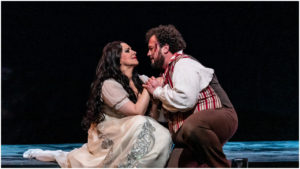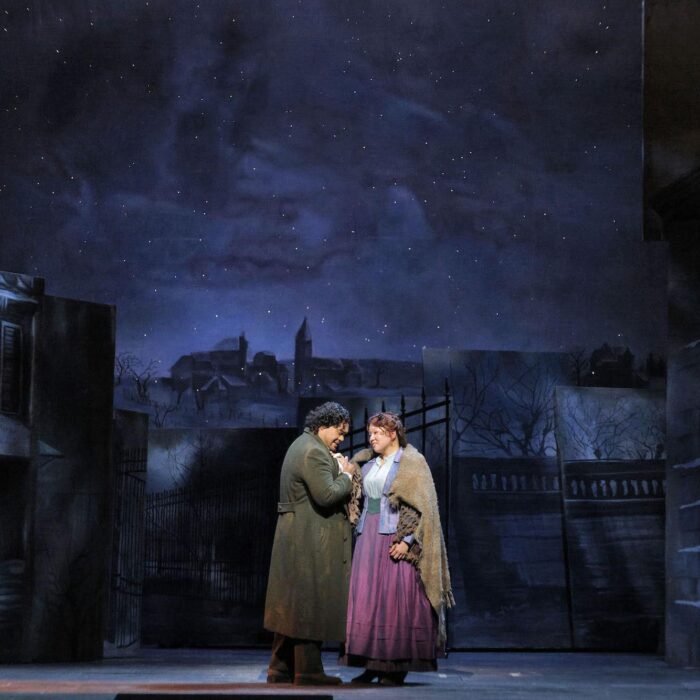
Royal Opera House Review 2021-22: Tosca
A Disappointing Diva Leads a Strong Cast in this Season’s Second Revival of Jonathan Kent’s Production
By Benjamin Poore(Photo: © Clive Barda/Royal Opera House)
“Tosca” is back at Covent Garden, for the second time this season, revived by Lucy Bradley and conducted by Marco Armiliato. It is especially notable as it marks thirty years since the house debut of Angela Gheorghiu, who returns in what is something of a signature role in a production over which she has considerable ownership.
Jonathan Kent’s production isn’t big on subtlety, with glowering designs by Paul Brown, but it’s still got a few touches that elevate it above being mere star-fodder. (There is probably no need here to rehash complaints about a need for a new staging from a fresher director, despite the fact that it is not yet twenty years old.) In the Palazzo Farnese Scarpia’s enormous wooden bookshelves lie mostly empty, as if rapidly and indiscriminately cleared. It’s a visual elaboration of a small character moment in Act one. As Scarpia searches Cavaradossi’s painterly paraphernalia, he discovers a book, presumably some seditious tract (Rousseau or Paine, one imagines) and denounces him as a freethinker. The empty shelves, likewise purged of thinking differently, remind us of Scarpia’s ruthlessness when it comes to purging not just the bodies but the souls and minds of his enemies. He delights, of course, in seeing Tosca’s spirit broken before he tries to rape her.
Other threads catch the eye too: the water Scarpia takes from the font to cleanse his hands before greeting Tosca in Act one, offset by the glasses of wine consumed throughout Act two, and then recapitulated in the bathing soldier who – ironically? – washes himself before executing Cavaradossi, a tiny act of purification in an unclean world of spies and double-crossing. Water into wine, and then back again, as if to play on the opera’s deeply Catholic sensibilities. Cavaradossi’s final open-armed pose in front of the firing squad is a clear homage to Goya’s “The Third of May 1808”, in another nice piece of cultural detailing from the period.
An Uneasy Diva
But at the end of the day, the audience is probably mostly here for one thing: the diva Gheorghiu, in what is supposed to be a signature role in a production launched by her way back when. She does not so much play Tosca as she plays herself these days, and the reaction of the audience on opening night could’ve been lifted straight from the dripping prose of James McCourt’s paean to operatic excess “Mawrdew Czgowchwz.” As soon as she stepped onstage a ripple of applause greeted her; when Scarpia appeared there was a scattering of audible hisses. Ovations were extravagantly given and, well, just as extravagantly received.
This all seemed rather out-of-kilter with a somewhat overcooked vocal performance. Gheorghiu has never had the biggest voice and boisterous playing from the ROH band didn’t help; she also had to compete with bold and ringing voices from her co-stars, who shone rather more brightly. Intonation was wayward in the moments of greatest excitement, drifting dangerously sharp in her Act three duet, and she sounded hard- rather than gilt-edged above the stave. Vibrato at both ends of the voice was wide indeed, and the ensemble with the pit felt treacherous and uncoordinated – something that should’ve been solved by the time the stage and orchestra rehearsal came around.
Armiliato seemed to have quite different ideas about the shape of “Vissi d’arte” to the diva, where a lack of vocal power and errant phrases stymied Gheorghiu. So too was there a surprising overreliance on the prompt box, which one seldom sees gracing the Covent Garden stage these days, which made the action sequences flag. From the dramatic side, Gheorghiu does make heavy weather of spotlight moments, milking them for all their worth; even in an opera where less isn’t necessarily more, her final lines of Act two felt stolid and ponderous, delivered with an effortfulness that is completely at odds with Puccini’s zippy realism (even if it is opera). At least all is well in the middle register – velvety, responsive, and full of vulnerability in Act two.
Two Thrilling Voices
But there are two very good reasons to catch the show. First, Michael Volle’s barnstorming Scarpia, deliciously derring-do and sung with real oomph. The focus and intensity of his voice, buzzing with squillo, made his exchanges with Stefan Pop’s Cavaradossi utterly thrilling, especially in the climactic trio following news of Napoleon’s victory at Marengo, for once reminding us that the politics of the opera are more than just a scenario on which to hang some arias.
As a realization of the role, Volle offered a huge amount through smart movement. Gestures like a curt nod of the head or crisp wave of a hand to summon a flunkie were done with the brusque carelessness of someone entirely used to getting their own way. When Spoletta delivered the news of Angelotti’s suicide, refusing to be taken alive, Volle just shrugged as if to say: ‘these revolutionaries…how vain!” Just another day at the office for a thug in a fancy coat. He was as camp as the proverbial row of tents in Act one, and especially in the big closer: oily dissimulation that Tosca doesn’t seem to buy at all, lecherous grasping, and religious fervor that saw him shuddering at the conclusion of the “Te Deum.” His repeated “Va’s” in that sequence always got a different shading – a little gush of yearning, or a flick of disdain.
Stefan Pop impressed too; a superb follow-up to Freddie di Tommasie’s sparkling debut in the role before Christmas. It took a while to get going after a slightly mechanical “Recondita Armonia,” with some sluggish changes of register, but Puccini admittedly doesn’t make it easy right at the top of the show. Thrilling singing from then on, though. His Act two “Vittoria” was of heavenly length and precision. His voice is brassy and has a great gleam, but with the kind of bend that reminds us of Pop’s expertise in the bel canto repertoire. A showstopping “E lucevan le stelle” used this range to great effect, beginning with lucid, smooth phrases before pinging out the big climaxes, with an especially taut and anguished ending.
Bit parts were executed, so to speak, with vigor and imaginative detail, from Aled Hall’s needling Spoletta to Chuma Sijeqa’s wounded, desperate Angelotti. Alexander Köpeczi made his mark as the Sacristan. It is a role often taken by older singers – not least the superb Jeremy White in this house – but here a more youthful realization set him up as a good foil to Cavaradossi, the faithless artist and revolutionary (who of course spurns a priest before his execution), showcasing a difference in vocation rather than generation. The choirboys were another high point in such a familiar production: barrelling around with remarkable zest and naturalism, and in equally brash voice. Marco Armiliato directed the orchestra with swagger, pulling especially fine playing from the brass, and capturing the cloak-and-dagger chiaroscuro of Puccini’s score with clarity and verve.


